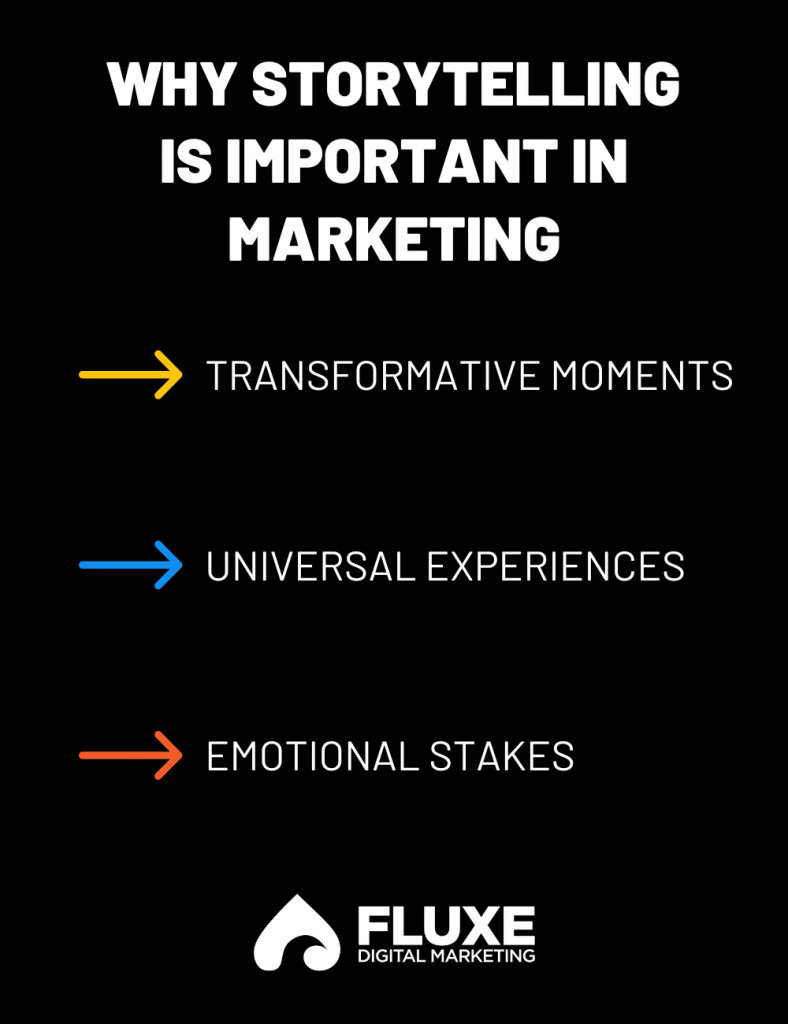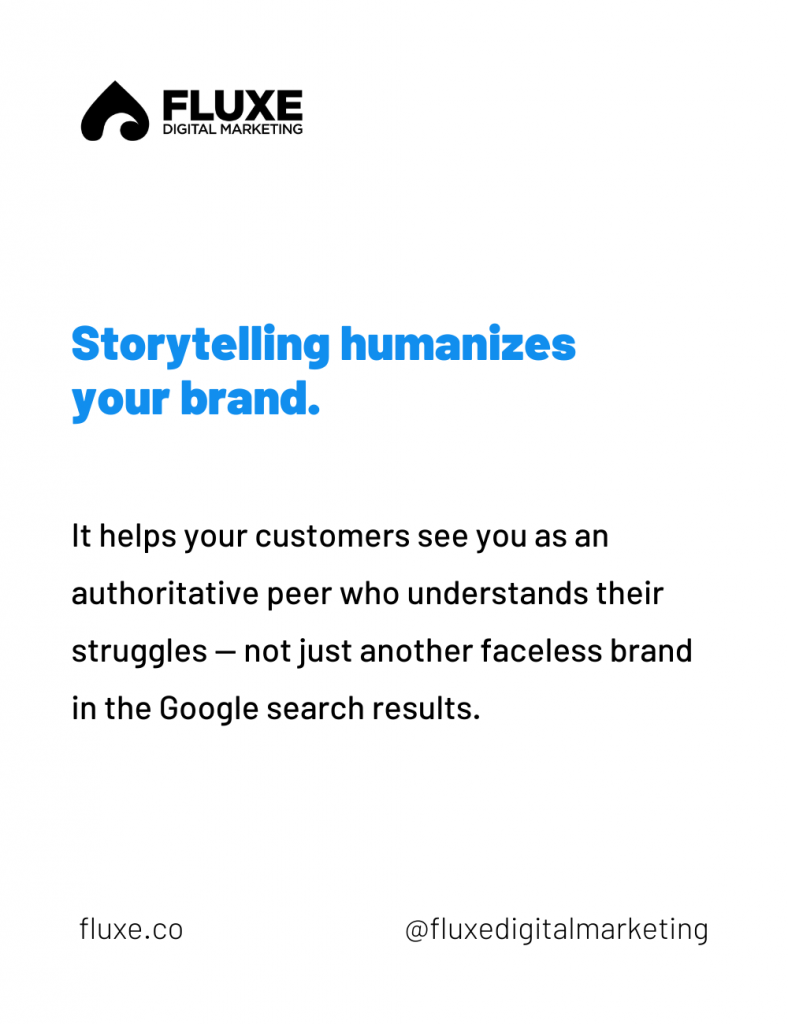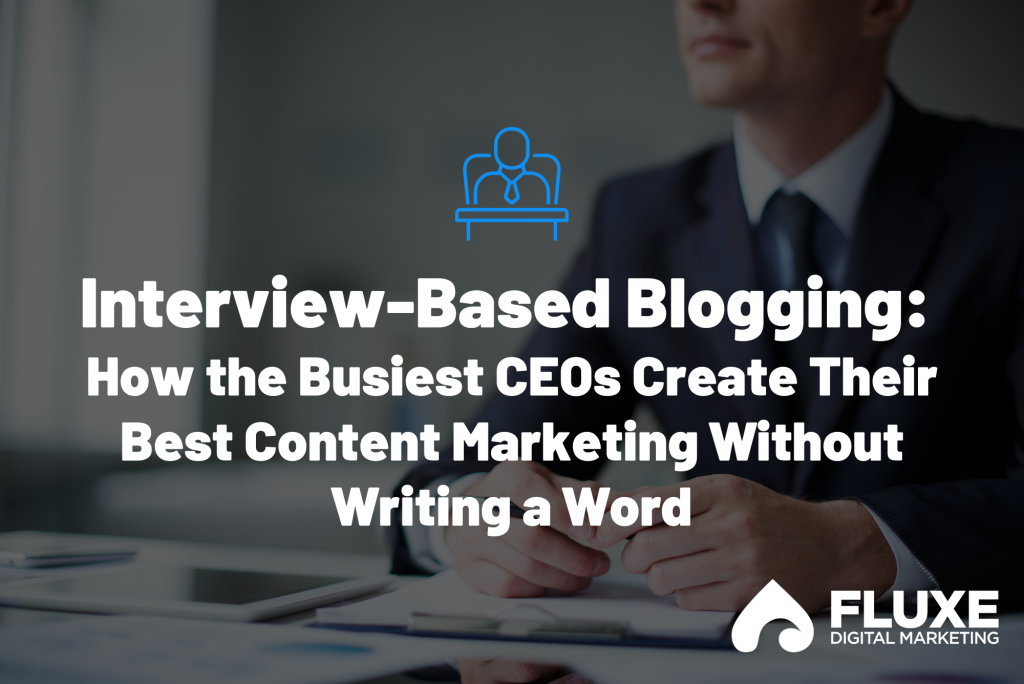Your business’s growth hinges on your ability to sell your product or service. But what sets truly successful salespeople apart?
It’s not the number of fancy conferences or workshops they’ve attended. It’s not even their years of experience.
It’s their ability to tell great stories.
Today, I’ll explore why storytelling is important in marketing and how to use stories to boost your bottom line.

Why Storytelling Is Important in Marketing
Great stories motivate prospects to buy. Why? Because they include:
1. Transformative Moments
Every great sales story includes a transformative moment — a point where your product or service changes the customer’s world for the better.
This is why storytelling is important in marketing: It helps showcase your business’s impact on your customers’ lives.
Take a fitness equipment company, for example. Consider the difference between a blog post outlining all the technical features of their new treadmill vs. a post sharing the story of a happy customer who used that treadmill to go from overweight and depressed to fit and confident.
Which one better connects with prospects? The second — no contest.
By creating content that makes prospects say, “Hey, I want that transformation too!” you help them see your product as the key to achieving their goals.
2. Universal Experiences
Storytelling humanizes your brand. It helps your customers see you as an authoritative peer who understands their struggles — not just another faceless brand in the Google search results.
Comedian Hasan Minhaj does this extremely well. He begins one of his most successful comedy specials with a deeply personal story about his struggle with male infertility.
The audience eats it up. Why? Because right off the bat, Hasan uses a funny and relatable struggle to demonstrate to his audience that he isn’t high and mighty. He faces obstacles just like them.
By establishing trust with his audience, he sets the tone for the rest of the special’s success.
You don’t need to get this personal with your audience, and you don’t even need to discuss your own experiences. Just share relatable, authentic stories that humanize your brand.

3. Emotional Stakes
Great sales stories evoke powerful emotions, such as excitement, relief, or a sense of possibility.
Imagine a software company telling the story of a small business owner who, using their tools, automated his processes, doubled his revenue in a year, and rewarded all his employees with a well-deserved raise.
Maybe that raise helped him keep his top-performing account manager, or it helped one of his employees buy their dream home.
Such emotionally resonant achievements appeal to universal experiences and desires. They create a sense of urgency and investment that pushes your prospects to buy. And guess what? AI can’t create that feeling.
A Framework for Impactful Sales Stories
So, you know why storytelling is important in marketing. But how do you tell a story that gets results?
Start with the following framework:
Intention and Obstacle
Effective storytelling requires a clear understanding of the character’s intentions and the obstacles they face. By defining what the character wants and who or what is standing in their way, you can create a compelling, relatable narrative.
For example, in the Harry Potter series, Harry’s intention is to live and defeat the villain, Voldemort. Voldemort’s efforts to kill Harry pose the obstacle that drives the story.
Perhaps your prospect’s stakes aren’t life-and-death, but it can certainly feel that way if they face a formidable obstacle. Showing your prospects that you understand their problem makes them more likely to believe you have the solution.
Three-Act Structure
Use the classic three-act structure to build great sales stories that address your prospects’ obstacles:
- Act 1: Introduce a customer, their goal, and their obstacle.
- Act 2: Present your product or service as the solution to overcoming that obstacle.
- Act 3: Demonstrate how your product or service helped that customer achieve their goal.
For this structure to drive sales, you have to genuinely understand the obstacles your target customers face.
For instance, if you’re a concierge doctor, your target customers are frustrated with the traditional healthcare system and want a more hands-on approach to managing their well-being. If you’re a high-quality furniture retailer, your customers are sick of purchasing tables that start to peel, warp, or wobble within a year or two.
Hooks and Framing
Captivating stories begin with a strong hook that immediately grabs the audience’s attention, like the opening line of a joke that leaves them eager to hear the punchline.
The amount of time you have to grab the audience’s attention depends on the platform. On TikTok, which is meant for quick consumption, you need to get your audience’s attention in the first second (not an exaggeration!), or they’ll keep scrolling. But during a podcast episode, which is meant to be digested over a half hour or so, you have some leeway to shoot the breeze before diving into your topic.
Either way, use your hook strategically.
Expert Storytelling Tips
Think of your favorite copywriter. Laura Belgray? Gary Vaynerchuck? Whoever it is, here are the tips that drive their success:
Write to One Person
Don’t imagine your audience as a nameless, faceless mass. Think of your target customer and pretend they’re the only person who will hear (or read) your story.
How old are they? What do they do for a living? What do they value? You should be able to answer these questions at the drop of a hat.
If you’re struggling to make someone up, think of someone you know personally who fits your target demographic.
Avoid Pretentiousness
Eliminate any false bravado or attempts to appear more knowledgeable than your audience. Nothing turns a person off like being talked down to!
Maintain Interest Regardless of Length
Your story’s length isn’t as important as its ability to keep the audience engaged.
Whether it’s a short, concise narrative or a longer, more detailed account (which depends on the platform you use), the key is sustaining the audience’s attention and interest.
Never Stop Improving
Even the best storytellers need to hone their craft. Pursue opportunities to learn not just from successful salespeople but from experienced storytellers — authors, comedians, public speakers, etc.
By learning from the best, you avoid becoming stale by accelerating your growth as a sales storyteller and creating even more powerful narratives.
Share Your Knowledge
As you develop your storytelling expertise, share your techniques with your team.
This doesn’t mean handing everyone an identical script. By coaching and mentoring your employees, you empower them to create their own sales narratives.
Encourage your team to focus on customer success stories they’re passionate about and give regular feedback. When they understand why storytelling is important in marketing, they’ll create narratives that sell.
Embrace the Power of Storytelling in Sales and Marketing
Remember to stay authentic, embrace vulnerability, and keep improving. When you truly understand why storytelling is important in marketing, your ability to connect, influence, and close deals will reach new heights.
Your stories have the power to change lives and grow your business, so start using storytelling in your marketing today.



